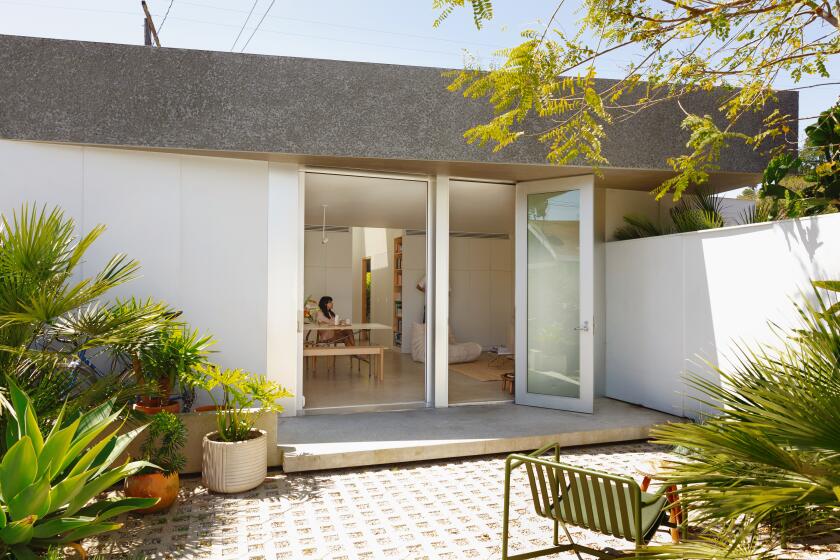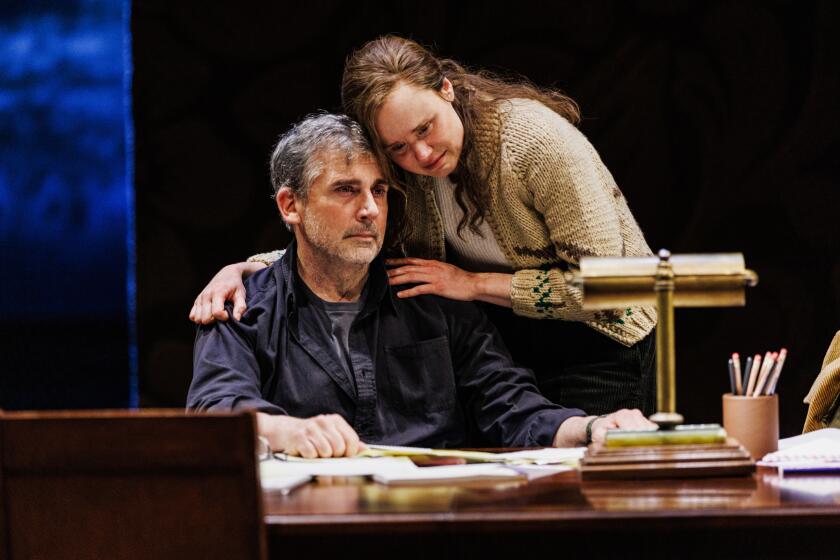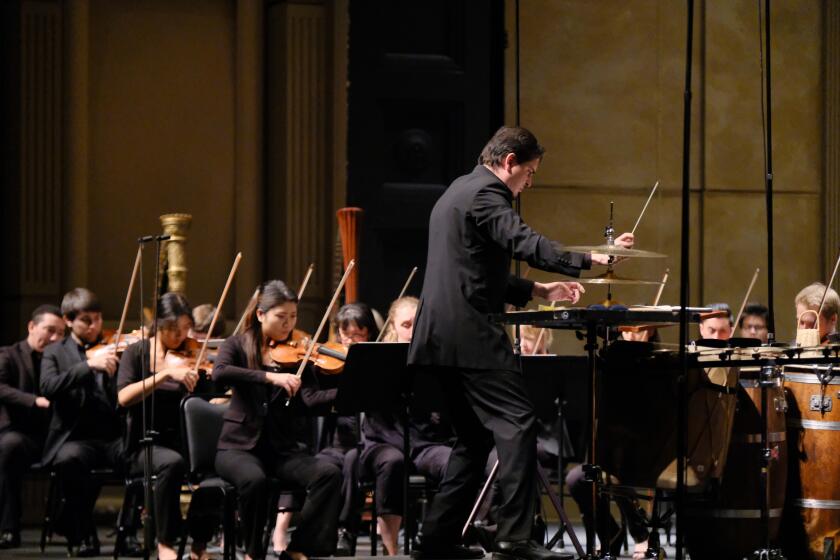A group’s power to unsettle us
In the early 1990s, lots of artists got lots of attention for making works about their personal problems. The subgenre of “identity politics” was invented to describe such imagery, basically a newfangled form of self-portraiture.
In the late 1990s, lots of artists got lots of attention for making works about other people’s problems. Selfless virtue replaced self-satisfied navel-gazing as identity politics gave way to “community-based activism.”
Evan Holloway’s new sculptures turn these developments upside down and inside out. Rather than focusing on the individual at the expense of the group (or vice versa), the figurative works at Marc Foxx Gallery offer a sustained meditation on the relationship between the individual and the group.
In Holloway’s multi-part pieces, self-consciousness neither hides in the privacy of a person’s interior world nor disappears into a crowd’s collective energies. Instead, it’s the main problem to be reckoned with in a world that has gone global, especially in a democracy as massive -- and powerful -- as ours.
A formalist to the core, Holloway begins with a cube, a circle, an arc and a sphere. But unlike old-fashioned formalists, who shunned figuration, he embraces it shamelessly. Some might say distastefully. But there’s always a point to the lowbrow theatrics that give Holloway’s art its political kick.
Twenty-seven nude figurines, in various shades of fleshy tan, pink and yellow, populate his cube-shaped sculpture. Cast from a synthetic substitute for clay, each of the toy-size men has lumpy limbs, a potbelly, mitt-like hands and a wide-eyed expression that can be read as surprise, shock or speechless incomprehension.
Holloway’s little men are linked to one another by thin metal rods coated with gloppy brown paint. Some of these feces-tinted rods run straight from one figure’s mouth to another’s anus. Others are bent at right angles. But they still link one end of someone’s digestive tract to the other end of someone else’s. This allows Holloway to construct three interlinked layers, each consisting of three rows and three columns of hapless yet sympathetic men.
Titled “Equity,” his multilayered piece of cartoon realism balances precariously on a slightly thicker but similarly coated pole. The setup resembles a schematic globe for a world that has gone flat, its inhabitants reduced to their most basic functions, where living hand-to-mouth seems like a luxury.
Holloway’s primitive piece of geometry also resembles a 3-D game of tic-tac-toe, models of molecular structures, Tinkertoys and shish kabob from a malevolent children’s story. It insists that if you dish it out you had better be able to take it.
“Anti Hierarchy” is a giant steel ring that hangs from the ceiling like a rudimentary mobile. To its interior Holloway has affixed approximately 150 human faces cast from a plaster-like substance.
Their skin colors range from dirty whites to ashen blacks, with all manner of earthy browns in between. Despite the generally stoic demeanor of each, none seems generic or interchangeable with any other. Like a medieval wheel of fortune, Holloway’s sculpture embodies the belief that all is transient. What goes around comes around.
“I Don’t Exist” is an arc-shaped wall sculpture that puts a viewer on the spot by confronting you with nearly 50 staring faces. None is quite life-size, but each is all the more mesmerizing for its small scale.
Once you engage any of these pieces, it’s difficult to break free without asking tough questions about one’s place in the world, not to mention power, privilege and responsibility. Holloway’s other works, including drawings, collages, 14 miniatures and a 3/5 -scale Styrofoam statue of Abraham and Isaac, drive these points home.
Not so long ago, artists often raised and resolved such issues with us-versus-them certitude. Today, the story is more complicated and the answers more ambivalent. Holloway acknowledges both in works that build on such diverse precedents as Alberto Giacometti, Anthony Gormley, Alexis Smith and Karen Carson. They all eschew superficial differences between people to make room for more primitive forms of social intercourse and, ultimately, greater civility.
Marc Foxx Gallery, 6150 Wilshire Blvd., (323) 857-5571, through Nov. 13. Closed Sundays and Mondays.
A Pop take
on flight
If the paint job on SpaceShip- One were as sophisticated as the technology under its hood (or nose cone), the compact commercial craft would look like a painting by Robert Acuna. At Cartelle Gallery, 11 new acrylics on panel take the artistry of hot rod painting into the 21st century, where it whooshes toward the heavens without forgetting how sexy life on Earth can be.
Each of Acuna’s abstractions strips things down to the basics. Then it squeezes every bit of juice from them. His palettes are simple. Two-tone combos predominate, with purple and periwinkle or silver and olive set against creamy white sections, the sweeping contours of which resemble streamlined birds.
Sometimes Acuna plays two shades of one color (say, rosy red and hot pink) against another (mint green). At other times he divides sections of pure and pearlescent white with laser-sharp racing stripes.
All of Acuna’s paintings include window-shaped slices that open onto illusionistic deep space. Arranged vertically (as if for takeoff) or horizontally (for the long haul) these hard-edged sections are packed with thick swipes of paint applied with a palette knife and plump droplets of color carefully poured in round puddles. They suggest the unfathomable vastness of the cosmos and the primordial ooze hard-core painters like to muck around in.
Most of Acuna’s panels are square, but two long rectangles, a circle and a surfboard-shaped work flaunt his facility with eccentric formats. Like University of Nevada-Las Vegas classmates David Ryan and Yek, Acuna brings hedonism and Pop painting together in a way that screams Southern California.
Cartelle Gallery, 310 Washington Blvd., Suite 119, Marina del Rey, (310) 574-9689, through Nov. 10. Closed Mondays.
Odd pairing
provokes thought
At Santa Monica College’s Barrett Art Gallery, “Seeing & Reading” pairs representational paintings by Marc Trujillo with cartoon drawings by Chris Ware. It’s an odd mix of media that makes an odd sort of sense, but only if you’re willing to think outside the box.
On first look, the cartoonist’s pencil on Bristol board drawings have little in common with the painter’s oils and acrylics on canvas, panel and paper. Ware’s black-and-white graphics divide each poster-size page into tidy fragments. Across these left-to-right, top-to-bottom setups, ordinary (and not so ordinary) stories unfold sequentially.
Text, representing spoken words and silent thoughts, drives the generally sardonic narratives. They articulate a love of life’s painful absurdities.
Trujillo’s realistic depictions of grocery store interiors (along with Laundromats, multiplexes, discount outlets and mini-mall exteriors) present panoramic views of the environment in which budget-conscious consumerism is the order of the day. Your eyes simultaneously glide across these beautifully painted surfaces and peer into their carefully composed spaces, where long aisles, longer halls and endless rows of cheap products continue to the artificial horizon.
When signs appear, Trujillo breaks their letters and numbers into abstract patterns that may spell things out if you squint. But no stories unfold.
After a while, it becomes clear that both artists are astute observers of the world. Seven vitrines filled with sketchbooks and drawing pads suggest an old-fashioned commitment to working directly from life. The long, solitary hours required by this fidelity to what seems obvious give Trujillo’s and Ware’s work uncanny depth and resonance. The poetry of the pairing unfolds slowly and sticks in your head.
Barrett Art Gallery, Santa Monica College, Madison Campus, Santa Monica Boulevard at 11th Street, (310) 434-3434, through Nov. 6. Closed Sundays and Mondays.
Cloud art doesn’t match real thing
Every year or so, when the atmospheric conditions are just right, huge cumulus clouds appear in the sky over Los Angeles. There’s nothing like it, especially when the rest of the sky is crystal clear, like a flat blue screen.
This makes the puffy white clouds look so crisp and super-dimensional that they seem to be magical mountains towering beyond the imagination’s farthest reaches. The best thing about Diana Thater’s installation at 1301PE Gallery is that it recalls such experiences.
But the artist’s digital projection of clouds on the walls and ceiling of the dimly lighted gallery pales in comparison to the real thing. Titled “White Is the Color,” its pleasures are modest and utterly conventional. If you find yourself worn weary from more demanding art and aren’t ready for traffic, take a break in Thater’s exhibition.
Unfortunately, no chairs, cushions or rugs share the floor with the two projectors, two DVD players, a fluorescent light fixture and a tangle of electrical cords required for the bare-bones show to go on.
You’re in an art gallery, after all, and the lack of creature comforts is meant to signify intellectual seriousness. To my eye, you’re looking at the emperor’s new clothes.
1301PE Gallery, 6150 Wilshire Blvd., (323) 938-5822, through Nov. 6. Closed Sundays and Mondays.
More to Read
The biggest entertainment stories
Get our big stories about Hollywood, film, television, music, arts, culture and more right in your inbox as soon as they publish.
You may occasionally receive promotional content from the Los Angeles Times.






